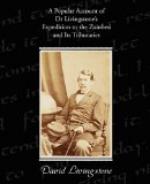Everything not to be accounted for by common causes, whether of good or evil, is ascribed to the Deity. Men are inseparably connected with the spirits of the departed, and when one dies he is believed to have joined the hosts of his ancestors. All the Africans we have met with are as firmly persuaded of their future existence as of their present life. And we have found none in whom the belief in the Supreme Being was not rooted. He is so invariably referred to as the Author of everything supernatural, that, unless one is ignorant of their language, he cannot fail to notice this prominent feature of their faith. When they pass into the unseen world, they do not seem to be possessed with the fear of punishment. The utensils placed upon the grave are all broken as if to indicate that they will never be used by the departed again. The body is put into the grave in a sitting posture, and the hands are folded in front. In some parts of the country there are tales which we could translate into faint glimmerings of a resurrection; but whether these fables, handed down from age to age, convey that meaning to the natives themselves we cannot tell. The true tradition of faith is asserted to be “though a man die he will live again;” the false that when he dies he is dead for ever.
CHAPTER XIV.
Important geographical discoveries in the Wabisa countries—Cruelty of the slave-trade—The Mazitu—Serious illness of Dr. Livingstone—Return to the ship.
In our course westwards, we at first passed over a gently undulating country, with a reddish clayey soil, which, from the heavy crops, appeared to be very fertile. Many rivulets were crossed, some running southwards into the Bua, and others northwards into the Loangwa, a river which we formerly saw flowing into the Lake. Further on, the water was chiefly found in pools and wells. Then still further, in the same direction, some watercourses were said to flow into that same “Loangwa of the Lake,” and others into the Loangwa, which flows to the south-west, and enters the Zambesi at Zumbo, and is here called the “Loangwa of the Maravi.” The trees were in general scraggy, and covered, exactly as they are in the damp climate of the Coast, with lichens, resembling orchilla-weed. The maize, which loves rather a damp soil, had been planted on ridges to allow the superfluous moisture to run off. Everything indicated a very humid climate, and the people warned us that, as the rains were near, we were likely to be prevented from returning by the country becoming flooded and impassable.




